We hope that each of you will greatly enjoy and appreciate this article we present about these 4 Charming Christmas Season Species. It was certainly our pleasure to gather the information for you. May it provide you with both education and increased awareness.
Certainly, these species listed here represent only a few of the amazing species associated with this period. It’s our belief, though, that they serve as excellent representations of those often encountered. Check out some of our other articles for similar marvels.
Common Holly
Common Holly Facts
- Starting off this article listing 4 Charming Christmas Season Species comes the colorful wonder given the name of Common Holly.
- This magnificent creation of Nature and evolution most frequently goes by the general name we’re using here across much of its native range. Yet, it also holds several other common names. In this respect, it’s like many other species around the world.
- These alternate terms include such informative names as the Christmas holly, due to its cultural usage. Others, however, include English holly, European holly, or simply holly. Regardless of which of these one uses, it’s a beautiful and intriguing variety of flora.
- Among scientific professionals, though, it’s generally referred to by its technical name. That’s the relatively simple, though perhaps less appealing, term of Ilex aquifolium. It’s a member of the only genus in its Family, which currently contains at least 560 species.
- It further received its technical name at the hands of the renowned Swedish botanist, Carl Linnaeus. He made the first formal recognition of it as a separate and distinct species. The scientist accomplished this scientifically noteworthy recognition in 1753.
- Fortunately, the Common Holly merits its name. That’s because its populations appears to be both stable and sufficient. This also seems to hold true throughout the entirety of its range. The IUCN, therefore, presently list it as Least Concern on its Red List.
- The gorgeous Angiosperm nevertheless does face potential threats to its existence. Due to human expansion, habitat loss might one day threaten it. Its greatest danger, however, likely consists of the ever-increasing effects of ongoing climate change.
Common Holly Physical Description
Despite its deceptive name, the Common Holly is anything but ordinary. It is, in fact, quite special, for various reasons. Chief among those, perhaps, comes its remarkable versatility. That’s due to the fact that the variable evergreen appears as either a shrub or tree.
Due to that variability, sheer physical size often varies significantly. The larger specimens, developing as trees, frequently reach heights in excess of 33 ft (10 m). Typically, however, it develops as a shrub. These usually range from 6.6 – 9.8 ft (2 – 3 m) in height.
Exceptional specimens of the flora do exist, though. A few of these outstanding individual plants measure as much as 82 ft (25 m) in height! Regardless of the heights various examples attain, however, its overall physical characteristics remain otherwise quite similar.
The central structure of the plant consists of a tall woody stem. The diameter of this obviously varies, depending on how tall the plant grows. Generally speaking, though, this measures between 16 – 31 in (40 – 80 cm) in diameter. But, a few have reached 39 in (99 cm).
From this central feature, numerous leaves branch off. This foliage further averages 2 – 4.7 in (5 – 12 cm) in length, and 0.8 – 2.4 in (2 – 6 cm) in width. These also have an evergreen nature, being a darker green on the upper surface, and lighter on the underside.
Meanwhile, the flowers of the Common Holly provide a dazzling color contrast. These manifest as bright white, and in copious numbers. The fruit also augments the beauty of the amazing plant. Though quite small, these appear as either a very bright yellow or red.
- Kingdom: Plantae
- Phylum: Trachyophyta
- Class: Angiosperms
- Order: Aquifoliales
- Family: Aquifoliaceae
- Genus: Ilex
- Species: I. aquifolium
Common Holly Distribution, Habitat, and Ecology
Fortunately for the intriguingly-named Common Holly, it evolved as endemic to a relatively broad swathe of the globe. That’s because it’s native to portions of three continents. Those regions include southwest Asia, northwest Africa, and southern and western Europe.
Due to human activities, though, it’s now been spread to other parts of the world. In some of those regions, however, it’s now become considered an invasive species. That’s especially true, though, on the east coast of North America, from Canada to the United States.
In all regions it appears in, however, the plant demonstrates the same environmental preferences. Due to that, the vast majority of specimens appear in relatively moist regions. Despite this, it’s proven to be remarkably hardy, enduring both drought and frost.
The tantalizing flora possesses further defining preferences, though. It most often develops, and thrives, in various types of temperate forests. It also demonstrates a preference for the presence of a high percentage of deciduous trees, especially native oak varieties.
Within its native range, the Common Holly only merits the adjective in terms of frequency of presence. In the local ecosystem, it plays a vital role. Many animals, ranging from birds to deer, also frequently take refuge within its dense, thorny, labyrinthine structure.
Its flowers provide a further benefit to its local wildlife. Numerous bees, flies, butterflies, and wasps flock to them for nectar. Following the first frost, its fruits drop to the ground. These thus serve as a ready food source for winter birds, who subsequently spread its seeds.
Poinsettia
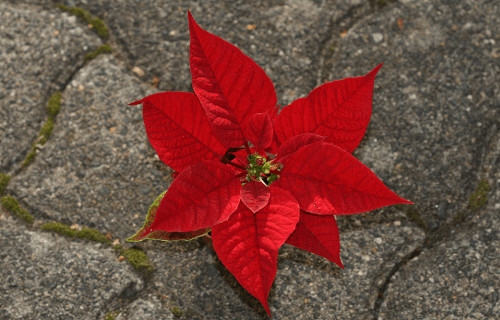
Poinsettia Facts
- Next up among our choices for inclusion in this compendium of 4 Charming Christmas Season Species comes the ever-popular Poinsettia.
- This beautiful, and widely renowned, flora most frequently goes by the simple common name used here. It has other general titles, though. These include such diverse terms as Christmas star, lobster plant, painted leaf, and Mexican painted leaf.
- Among scientific professionals, however, it’s better known by its technical title. But that’s a somewhat difficult term for the layperson to pronounce. That’s because this remarkable product of evolution holds the formal moniker of Euphorbia pulcherrima.
- It received that official name due to the efforts of the respected German botanist, Johann Friedrich Klotzsch. He accomplished the first formal acknowledgement of it as a separate and distinct species. Tht scientifically noteworthy event took place in 1834.
- Regardless of which term once chooses, it remains well known species. The beautiful flora qualifies as a culturally and commercially important plant in many parts of the world. That’s due to the fact that it remains widely used in Christmas decorations.
- Due to its enormous popularity in cultivation, the overall population of the Poinsettia remains sufficient. In the wild, however, its population numbers appear scattered and perhaps dwindling. For now, though, it does not appear on the IUCN Red List.
- That wild population faces several threats to its continued existence. Most of those stem from the actions of man. They include such factors as habitat loss due to deforestation. The naturally occuring plants also now face the perils of climate change.
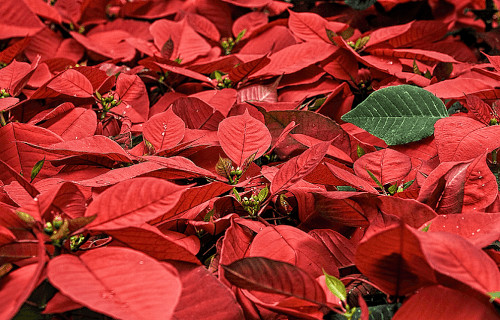
Poinsettia Physical Description
Perhaps most notably, the remarkable Poinsettia represents one of those uncommon plants that evolved a comparatively unique capacity. That’s because this stunning and incredible plant occurs naturally as either a shrub or small tree, depending on local conditions.
The impressive and remarkable tree form also has an impressive ability. In fact, it has the capacity to grow to heights measuring as much as an impressive 16 ft (4 m). Though that doesn’t compare to regular trees, it’s nonetheless incredible for this particular Angiosperm.
The lovely Poinsettia also bears foliage equally deserving of appreciation. This marvel of Nature produces dark green leaves that average between 3-6 in (7-16 cm) in length. The species also produces bracts that most commonly display the familiar bright red shade.
However, this intriguing plant sometimes develops as either orange, cream, pale green, pink, white or marbled, in color. When left to their own devices, these natural varieties typically grow into a wider form more closely resembling weeds than its more familiar shape.
- Kingdom: Plantae
- Phylum: Tracheophytes
- Class: Angiosperms
- Order: Eudicots
- Family: Euphorbiaceae
- Genus: Euphorbia
- Species: E. pulcherrima
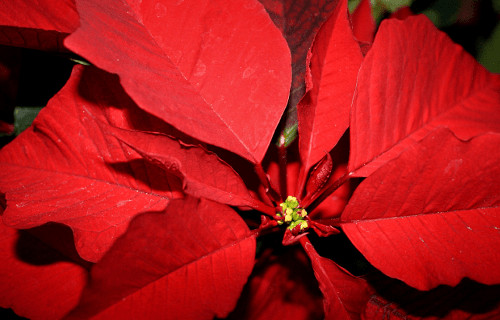
Poinsettia Distribution, Habitat, and Toxicity
Currently, the breathtaking Poinsettia grows in many parts of the world. This widespread dispersal occurs only due to its popularity in cultivation. Since the species originally evolved in Mexico and Central America, it still only appears in small parts of North America.
The species also evolved within a very specific habitat range and type in the wild. Incredibly, it also possesses quite precise requirements for its habitat. That holds true because the vast majority of those still growing wild in the original range appear in one specific area.
This habitat consists specifically of gentle slopes, facing the Pacific Ocean. Even more specifically, these only develop at roughly mid-range altitudes. An exception to this tendency does exist, though. That’s because one small grouping does appear further inland.
Nature often protects its greatest treasures in powerful ways, however. The beautiful Poinsettia is no exception to this. A common misconception concerning the relative toxicity of the plant still remains, though. It’s believed to be extremely dangerous to man.
The plant does rank as toxic, but only slightly, however. Ingestion of any part of the flora by humans rarely results in more than mild symptoms such as regurgitation. Prolonged contact with the leaves also results in only mild skin irritation in sensitive individuals.
Reindeer
Reindeer Facts
- Now appearing in this listing of 4 Charming Christmas Season Species is perhaps the most famous of them all, the gorgeous Reindeer.
- Perhaps most notably, the simple common name applies to a specific variety of deer with a total of 15 subspecies. All of these live as native to specific, and rather harsh, sections of the world. In some ways, this aids in their survival, however.
- The same awesome animal also goes by the name of caribou in parts of its native range, though. Regardless of the name one uses for the impressive creature, however, Indigenous Peoples in parts of its range depend on it for their very survival.
- In addition to the simple facts of its great beauty, one very special fact sets this remarkable creature apart from all other known animals. This characteristic actually formed as a unique adaptation to the climate in which the species evolved.
- Quite amazingly, the beautiful reindeer remains the only known mammal to possess the ability to see in ultraviolet light. Though still numerous, the population of this amazingly adapted mammal unfortunately appears to be in decline.
- The main reason for this seems to be climate change, much like many species around the world today. However, several other factors also threaten the magnificent animal. These include two separate parasites that threaten several local populations.
Reindeer Physical Description
The remarkable Reindeer holds more surprises, in this case in terms of its appearance. That’s because the color of the fur of the mammal varies widely, both in individuals and with the season. This represents yet another uncommon trait that the creature displays.
In point of fact, the coloring generally ranges from off-white to a dark brown. The fur further sometimes develops a most striking mottled pattern. In other aspects of its physiology, though, it displays many of the same traits that characterize many types of animals.
That’s due to the fact that it displays a mild degree of sexual dimorphism. That’s because, in its case, contrary to popularly held belief, both sexes develop antlers. This also sets it apart from related species, because it’s the only species whose females grow antlers.
Those of the mature female, however, generally develop as much smaller than those of the males. Yet overall, the antlers of this beautiful ruminant average up to 39 in (100 cm) in length. These features also attain an impressive average of 53 in (135 cm) in total width.
Mature male Reindeer grow larger than the females and average roughly 7 ft (2.13 m) in length, and weigh an average of 400 lb (182 kg). A few rare males attain a weight of up to 700 lb (318 kg). Typically, an adult also stands about 59 in (150 cm) tall at the shoulder.
- Kingdom: Animalia
- Phylum: Chordata
- Class: Mammalia
- Order: Artiodactyla
- Family: Cervidae
- Genus: Rangifer
- Species: R. tarandus
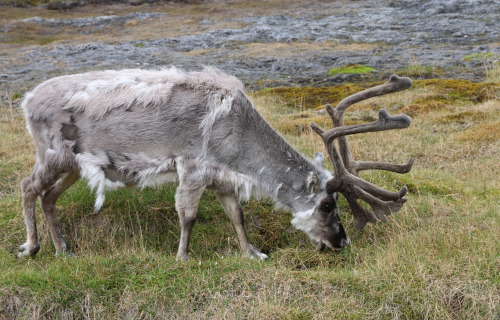
Reindeer Distribution, Habitat, and Ecology
The powerful and majestic Reindeer actually evolved as native to a most surprising part of the world. More precisely, the ruminant remains native to the Arctic and subarctic regions of the world. The impressive animal also migrates within its region of habitation.
This includes much of the tundra regions of the Northern Hemisphere. This range once extended much further south than it does today. Its range also naturally affects its diet. Being a large ruminant, the Reindeer primarily feeds upon a wide variety of local native plants.
These, however, most commonly include such plants as reindeer moss, grasses, sedges. Individuals also consume the leaves of willows and birches. It also feeds on lichen, as well. This further makes it the only known large mammal able to consume lichen.
Despite its relatively large size, it in turn falls prey to a number of predators. These vary, depending upon the region of the world it inhabits. Animals such as golden eagles and wolverines prey on the young. Only polar bears and brown bears feed on mature individuals.
Mistletoe
Mistletoe Facts
- Closing out this article about these 4 Charming Christmas Season Species we present the marvelous woody shrub known as Mistletoe.
- In general cultural usage, people apply the short term given herein to any of the related plants placed in the, perhaps humorously-named, Order of Santalales. Originally, however, the term was used to refer to the single specific species presented herein.
- It’s formal, scientific name’s relatively easy to pronounce, as such things go. That’s because it bears the technical name of the Viscum album. It has several common names, though. These include the terms of European mistletoe and common mistletoe.
- It further shares a distinction with many other species around the world. That’s due to the fact that the Swedish botanist and zoologist, Carl Linnaeus, made the first formal acknowledgement of it, officially recognizing it as a separate and distinct species.
- It’s featured prominently in cultural uses in many parts of the world, including Europe and North America. Though not native to the latter region of the world, it’s present in cultivation. In those regions where not found, related native species replace its usage.
- Fortunately, all known varieties of Mistletoe appear to be maintaining population bases that are both stable and sufficient. The IUCN therefore either lists them all as Least Concern, or has no current listing for them. That could potentially change, however.
- Like most species, it does face some threats to its continued existence. Habitat loss naturally poses a threat to the wild populations, of course. Yet its greatest source of danger most likely consists of the ever-growing perils presented by climate change.
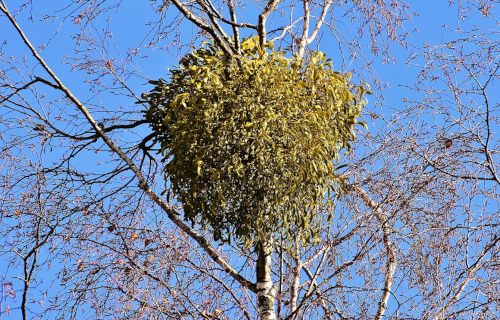
Mistletoe Physical Description
As a variety of Mistletoe, the amazing Viscum album evolved as a special type of evergreen shrub. That’s because it’s actually what botanists classify as a hemi-parasitical plant. This evolutionary path lead it to form different physical traits than many other flora.
In many ways, its general form resembles vines. This marvel of Nature and evolution produces numerous thin, elongated stems. Even among mature specimens, however, these display vastly different measurements, due to local environmental conditions.
The majority of individuals, though, produce copious stems that attain lengths averaging from 12 – 39 in (30 – 100 cm). Each of these further branch out multiple times. These also frequently tend to wind around each other, often producing a somewhat rounded shape.
Its leaves, meanwhile, typically appear in opposite pairs. They also usually display highly smooth, rounded edges, with a distinctive smooth leathery texture. This foliage additionally averages 0.8 – 3.15 in (2 – 8 cm) in length, and about 0.3 – 1 in (0.8 – 2.5 cm) in width.
That part of this particular form of the awesome Mistletoe generally presents a yellowish-green color. The flowers remain quite small, averaging no more than 0.12 in (3 mm) when open. The fruit also appears as a tiny, rounded berry, most often yellow or white in color.
- Kingdom: Plantae
- Phylum: Angiosperm
- Class: Eudicots
- Order: Santalales
- Family: Santalaceae
- Genus: Viscum
- Species: V. album
Mistletoe Distribution, Habitat, and Ecology
Fortunately, both for the beautiful Mistletoe itself, and for those of us who appreciate Nature, this particular variety inhabits a relatively broad swathe of the globe. That’s due to the fact that it evolved as endemic to certain portions of Africa, Europe and Asia.
It lives in most of Europe, beginning in Scandinavia, and moving southward. This also includes the isle of Great Britain. In Africa, meanwhile, it appears in parts of the northern section. But in Asia, the plant mainly lives in the eastern section, including Japan.
This incredible product of untold ages of evolution holds yet another advantage over many species. That’s because it evolved as highly general in its choice of habitat. More precisely, the resourceful plant appears wherever any of several varieties of trees appear.
It makes its home almost exclusively on several types of broad-leaf trees. These primarily consist of polar, hawthorn, lime, and apple trees, of various varieties. Though it does appear on other species occasionally, such divergence from the norm remains extremely rare.
From its home on its choice of host tree, this specific variety of Mistletoe, like its relatives, draws most of its nourishment directly from the host. These include water and nutrients taken via root-like structures. Those, however, extend under the bark of the tree.
It’s long been extremely popular in Western folklore, in connection with the Christmas Season. Surprisingly, this holds true despite the fact that this variety, the Viscum album, is highly toxic! Ingestion in concentration can even prove fatal in some instances.
4 Charming Christmas Season Species
We hope that each of you enjoyed reading, and hopefully learning from, this article we’ve written about these 4 Charming Christmas Season Species. It’s also our hope that doing so has left you with either a new or renewed appreciation for such wonders of Nature.
Unfortunately, many other such species around the world now find themselves facing threats to their continued existence as a species. Many of those dangers, in fact, stem from the actions of mankind. We must do all we can to protect and preserve them all.
Check out our other articles on 5 Marvelous Mediterranean Sea Species, Spectacular Halloween-Appropriate Species, 5 Marvelous Plants of Maine, The Mighty Tornado
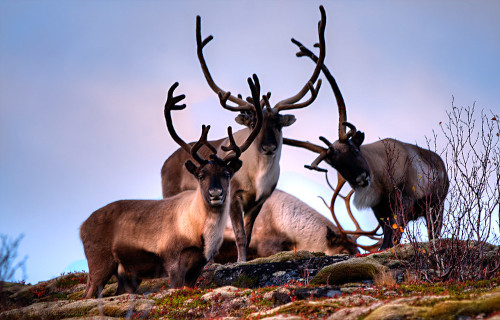
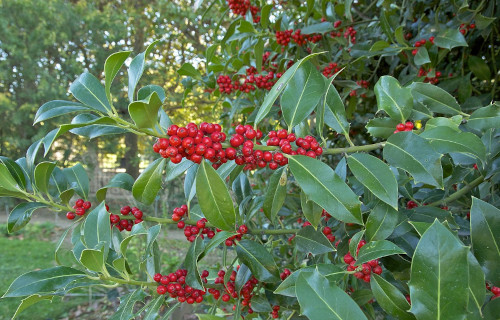
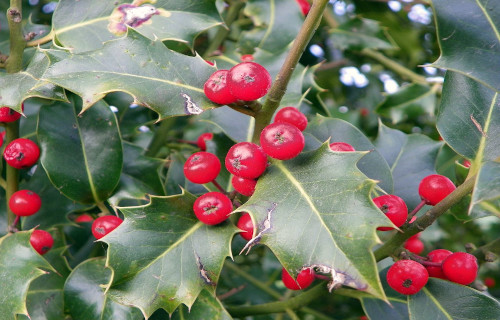
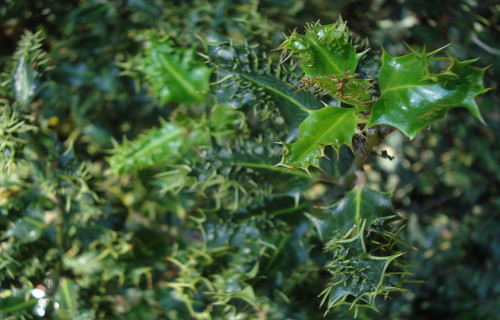
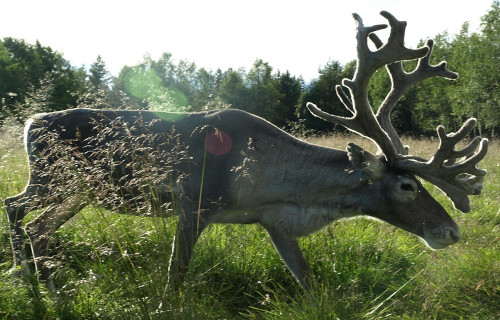
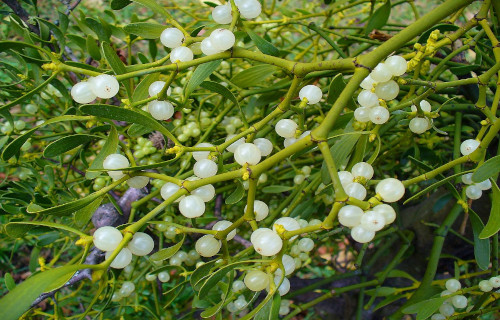
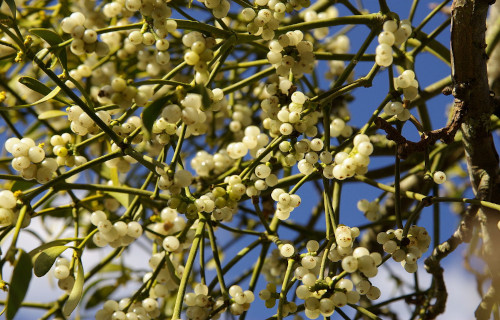









Leave a Reply